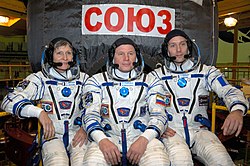Sojus MS-03
| Missionsdaten | |||
|---|---|---|---|
| Mission | Sojus MS-03 | ||
| Raumfahrzeug | Sojus 7K-MS (GRAU-Index 11F732) Seriennummer 733 | ||
| Rufzeichen | Казбек („Kasbek“) | ||
| Trägerrakete | Sojus FG (GRAU-Index 11A511FG) | ||
| Besatzung | 3 / 2 | ||
| Start | 17. November 2016, 20:20 UTC | ||
| Startplatz | Baikonur 1/5 | ||
| Raumstation | ISS | ||
| Andockplatz | Rasswet | ||
| Ankopplung | 19. November 2016, 21:58 UTC | ||
| Abkopplung | 2. Juni 2017, 10:47 UTC | ||
| Dauer auf ISS | 194d 13h 49min | ||
| Landung | 2. Juni 2017, 14:10 UTC | ||
| Landeplatz | 147 km SÖ von Schesqasghan, Kasachstan | ||
| Flugdauer | 196d 17h 49min | ||
| Erdumkreisungen | 3061 | ||
| Mannschaftsfoto | |||
 Peggy Whitson, Oleg Nowizki und Thomas Pesquet | |||
| ◄ Vorher / nachher ► | |||
| |||
Sojus MS-03 ist die Missionsbezeichnung für einen Flug des russischen Raumschiffs Sojus zur Internationalen Raumstation. Im Rahmen des ISS-Programms trägt der Flug die Bezeichnung ISS AF-49S. Es war der 49. Besuch eines Sojus-Raumschiffs an der ISS und der 155. Flug im Sojusprogramm.
Besatzung
Startbesatzung
- Oleg Wiktorowitsch Nowizki (2. Raumflug), Kommandant (Russland/Roskosmos)
- Peggy Whitson (3. Raumflug), Bordingenieurin (USA/NASA)
- Thomas Pesquet (1. Raumflug), Bordingenieur (Frankreich/ESA)
Ersatzmannschaft
- Fjodor Nikolajewitsch Jurtschichin (5. Raumflug), Kommandant (Russland/Roskosmos)
- Jack Fischer (1. Raumflug), Bordingenieur (USA/NASA)
- Paolo Nespoli (3. Raumflug), Bordingenieur (Italien/ESA)
Rückkehrbesatzung
- Oleg Wiktorowitsch Nowizki
- Thomas Pesquet
Peggy Whitson flog nicht mit Nowizki und Pesquet zurück, sondern blieb an Bord der ISS und verbrachte dort drei weitere Monate als Mitglied der ISS-Expedition 52.[1] Ihre Rückkehr erfolgte mit Sojus MS-04.
Missionsbeschreibung
Die Mission brachte drei Besatzungsmitglieder der ISS-Expeditionen 50 und 51 zur Internationalen Raumstation.
Es war der dritte Einsatz des weiterentwickelten Sojus-MS-Raumschiffs.[2] Dieses unterscheidet sich von der bisherigen Version unter anderem durch das neue Annäherungs- und Kopplungssystem Kurs-NA.[3]
Das Rendezvous mit der ISS dauerte wieder wie bei den zwei vorangegangenen Flügen zwei Tage, statt der zuletzt üblichen sechs Stunden. Grund war eine noch nicht betriebsfähige „Klion-R“ Bodenkontrollstation in Wostotschny, die für den schnellen Vier-Orbit-Anflug der neuen MS-Raumschiffe benötigt wird.[4]
Das Abdocken erfolgte schließlich am 2. Juni 2017 um 10:47 UTC, damit begann auf der Station die ISS-Expedition 52 mit Fjodor Jurtschichin als Kommandant. Die Landung erfolgte am selben Tag um 14:10 UTC 147 km südöstlich von Scheskasgan in der kasachischen Steppe.
Galerie
Siehe auch
- Liste der bemannten Raumflüge
- Liste der bemannten Missionen zur Internationalen Raumstation
- Liste der Sojus-Missionen
Weblinks
- Sojus MS-03 bei spacefacts.de
- Sojus MS-03 in der Encyclopedia Astronautica (englisch)
- Sojus MS-03 im Russian Space Web
- Sojus MS-03 im NSSDCA Master Catalog (englisch)
Einzelnachweise
- ↑ NASA: NASA Astronaut Peggy Whitson Adds Three Months to Record-Breaking Mission. In: NASA Press Release 17-038. 5. April 2017, abgerufen am 6. April 2017 (englisch).
- ↑ News 11.08.2011. RSC Energia, 11. August 2011, abgerufen am 25. Oktober 2014 (englisch).
- ↑ FliegerRevue April 2014, S. 9, Modernere Sojus und Progress-Kapseln
- ↑ Chris Gebhardt: Russian Soyuz launches Expedition 50 crew to Station. NASASpaceFlight, 18. November 2016, abgerufen am 18. November 2016 (englisch).
Auf dieser Seite verwendete Medien
A Russian Soyuz spacecraft can be seen in this image from the International Space Station as it passes over the American state of Florida surrounded by the blue waters of the Gulf of Mexico on the west side and the Atlantic Ocean on the other.
In the Integration Facility at the Baikonur Cosmodrome in Kazakhstan, Expedition 50-51 crewmembers Peggy Whitson of NASA (left), Oleg Novitskiy of the Russian Federal Space Agency (Roscosmos, center) and Thomas Pesquet of the European Space Agency (right) pose for pictures Nov. 2 in front of their Soyuz MS-03 spacecraft during a fit check dress rehearsal. They will launch Nov. 18, Baikonur time, for a six-month mission on the International Space Station. NASA/Alexander Vysotsky
The moon, or supermoon, is seen rising behind the Soyuz rocket at the Baikonur Cosmodrome launch pad in Kazakhstan, Monday, Nov. 14, 2016. NASA astronaut Peggy Whitson, Russian cosmonaut Oleg Novitskiy of Roscosmos, and ESA astronaut Thomas Pesquet will launch from the Baikonur Cosmodrome in Kazakhstan the morning of November 18 (Kazakh time.) All three will spend approximately six months on the orbital complex. A supermoon occurs when the moon’s orbit is closest (perigee) to Earth. Photo Credit: (NASA/Bill Ingalls)
A camera on the space station observes the Soyuz MS-03 spacecraft moments before docking to the Rassvet module.
Backdropped by a blanket of clouds, the Soyuz TMA-7 spacecraft departs from the International Space Station carrying astronaut William S. (Bill) McArthur Jr., Expedition 12 commander and NASA space station science officer; Russian Federal Space Agency cosmonaut Valery I. Tokarev, flight engineer; and Brazilian Space Agency astronaut Marcos C. Pontes. Undocking occurred at 2:48 p.m. (CDT) on April 8.
The Soyuz rocket is rolled out by train to the launch pad at the Baikonur Cosmodrome, Kazakhstan, Monday, Nov. 14, 2016. NASA astronaut Peggy Whitson, Russian cosmonaut Oleg Novitskiy of Roscosmos, and ESA astronaut Thomas Pesquet will launch from the Baikonur Cosmodrome in Kazakhstan the morning of November 18 (Kazakh time.) All three will spend approximately six months on the orbital complex. Photo Credit: (NASA/Bill Ingalls)
The Soyuz MS-03 spacecraft launches from the Baikonur Cosmodrome with Expedition 50 crewmembers NASA astronaut Peggy Whitson, Russian cosmonaut Oleg Novitskiy of Roscosmos, and ESA astronaut Thomas Pesquet from the Baikonur Cosmodrome in Kazakhstan, Friday, Nov. 18, 2016, (Kazakh time) (Nov 17 Eastern time). Whitson, Novitskiy, and Pesquet will spend approximately six months on the orbital complex.














